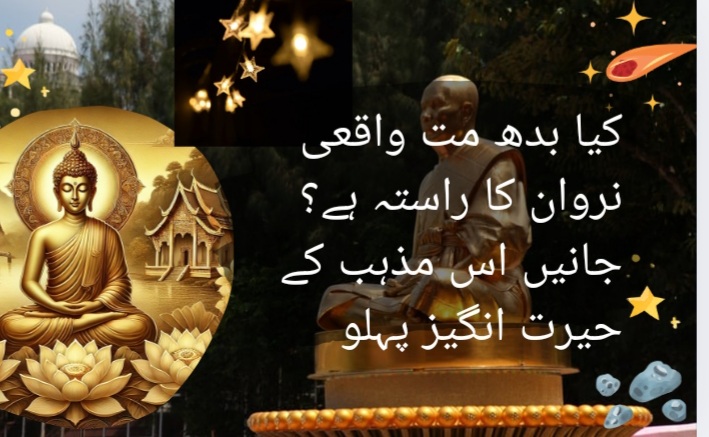“بدھ مت کے راز: وہ باتیں جو آپ کو ضرور جاننی چاہیے!”
بدھ مت دنیا کا چوتھا بڑا مذہب ہے، جس کی بنیاد مہاتما بدھ نے رکھی۔ یہ مذہب روحانی سکون، اخلاقیات، اور نروان (نجات) کے حصول پر زور دیتا ہے۔ بدھ مت نہ صرف ایک مذہب بلکہ ایک طرز زندگی اور فلسفہ ہے، جو ہزاروں سال سے دنیا کے مختلف خطوں میں لاکھوں انسانوں کی رہنمائی کر رہا ہے۔
بدھ مت کی تاریخ
سدھارتھ گوتم (مہاتما بدھ) کی زندگی
بدھ مت کی بنیاد سدھارتھ گوتم نے رکھی، جنہیں بعد میں “بدھ” کے نام سے جانا گیا۔
- پیدائش: مہاتما بدھ 563 قبل مسیح میں نیپال کے لومبینی کے مقام پر ایک شاہی خاندان میں پیدا ہوئے۔
- ابتدائی زندگی: سدھارتھ کی زندگی ابتدائی طور پر شاہانہ تھی، اور وہ ہر قسم کے غم و تکلیف سے محفوظ رکھے گئے تھے۔
- روحانی سفر: 29 سال کی عمر میں انہوں نے دنیاوی عیش و عشرت کو ترک کر کے روحانی سکون کی تلاش شروع کی۔
- گیان کا حصول: کئی سال کی ریاضت کے بعد، 35 سال کی عمر میں انہوں نے بودھ گایا (ہندوستان) کے مقام پر ایک پیپل کے درخت کے نیچے گیان حاصل کیا اور بدھ کہلائے۔
- وفات: مہاتما بدھ 80 سال کی عمر میں فوت ہوئے، لیکن ان کی تعلیمات آج بھی زندہ ہیں۔
بدھ مت کی بنیادی تعلیمات
بدھ مت کی تعلیمات اخلاقیات، گیان، اور نجات کے اصولوں پر مبنی ہیں۔
1. چار عظیم سچائیاں (Four Noble Truths)
بدھ مت کی بنیاد چار عظیم سچائیوں پر ہے:
- زندگی دکھ سے بھری ہوئی ہے۔
- دکھ کی وجہ خواہشات اور حرص ہیں۔
- خواہشات کا خاتمہ دکھ کو ختم کر سکتا ہے۔
- دکھ کے خاتمے کے لیے آٹھ گنا راستہ اختیار کرنا ضروری ہے۔
2. آٹھ گنا راستہ (Eightfold Path)
یہ راستہ نروان (نجات) کی طرف لے جاتا ہے:
- درست نظریہ
- درست نیت
- درست گفتار
- درست عمل
- درست روزگار
- درست کوشش
- درست توجہ
- درست مراقبہ
3. کرما اور پنر جنم
بدھ مت کے مطابق انسان کے اعمال (کرما) اس کی اگلی زندگی پر اثر انداز ہوتے ہیں۔ نروان حاصل کرنے تک انسان پنر جنم (جنم اور موت کا چکر) میں رہتا ہے۔
4. غیر تشدد (Ahimsa)
بدھ مت ہر قسم کے تشدد سے گریز کی تعلیم دیتا ہے اور محبت اور امن پر زور دیتا ہے۔
بدھ مت کے فرقے
بدھ مت میں تین بڑے فرقے موجود ہیں:
1. تھیرواد (Theravāda)
- بدھ مت کا سب سے قدیم فرقہ۔
- سری لنکا، تھائی لینڈ، اور میانمار میں عام ہے۔
- مہاتما بدھ کی اصل تعلیمات پر عمل کرتا ہے۔
2. مہایان (Mahāyāna)
- بدھ مت کا سب سے بڑا فرقہ۔
- چین، جاپان، اور کوریا میں عام ہے۔
- بدھ کی تعلیمات کے علاوہ دیگر فلسفوں کو بھی شامل کرتا ہے۔
3. واجریانا (Vajrayāna)
- تبتی بدھ مت کا حصہ۔
- بھوٹان، نیپال، اور ہمالیہ کے خطے میں پایا جاتا ہے۔
- گیان اور مراقبہ پر زور دیتا ہے۔
دنیا بھر میں بدھ مت
1. چین
- دنیا میں سب سے زیادہ بدھ مت کے ماننے والے چین میں پائے جاتے ہیں۔
- بدھ مت کے پیروکاروں کی تعداد تقریباً 244 ملین ہے۔
2. تھائی لینڈ
- بدھ مت یہاں کا سرکاری مذہب ہے۔
- 93 فیصد آبادی بدھ مت پر عمل کرتی ہے۔
3. جاپان
- جاپان میں بدھ مت اور شنٹو مذہب ایک ساتھ موجود ہیں۔
- بدھ مت کے ماننے والوں کی تعداد تقریباً 84 ملین ہے۔
4. میانمار
- میانمار کی 89 فیصد آبادی بدھ مت پر عمل کرتی ہے۔
- بدھ مت کی ثقافتی اہمیت بہت زیادہ ہے۔
5. سری لنکا
- سری لنکا میں بدھ مت کے پیروکاروں کی تعداد 14 ملین ہے۔
- بدھ مت یہاں کی ثقافت اور تاریخ کا حصہ ہے۔
6. نیپال
- نیپال مہاتما بدھ کی جائے پیدائش ہے۔
- نیپال کی 10 فیصد آبادی بدھ مت پر عمل کرتی ہے۔
7. بھوٹان
- بھوٹان میں بدھ مت سرکاری مذہب ہے۔
- یہاں کی تقریباً 75 فیصد آبادی بدھ مت پر عمل کرتی ہے۔
8. کمبوڈیا
- کمبوڈیا کی 97 فیصد آبادی بدھ مت پر عمل کرتی ہے۔
بدھ مت کے دلچسپ حقائق
- بدھ مت دنیا کا چوتھا بڑا مذہب ہے۔
- اس کے پیروکاروں کی کل تعداد 521 ملین سے زیادہ ہے۔
- بدھ مت مادیت کو ترک کرنے اور روحانی سکون پر زور دیتا ہے۔
- بدھ مت کی کوئی ایک مقدس کتاب نہیں، بلکہ مختلف متون اور تعلیمات موجود ہیں۔
- بودھ گایا، ہندوستان میں بدھ مت کا مقدس مقام ہے، جہاں مہاتما بدھ نے گیان حاصل کیا۔
بدھ مت کے اثرات
بدھ مت نے دنیا بھر کی ثقافت، آرٹ، اور فلسفہ پر گہرے اثرات ڈالے ہیں۔ بدھ مت کی تعلیمات نے امن، محبت، اور ہمدردی کا پیغام دیا، جو آج بھی دنیا بھر میں قابلِ قدر ہیں۔
Buddhism: History, Philosophy, Facts, and Global Influence
Buddhism is the fourth-largest religion in the world, founded by Siddhartha Gautama, known as Buddha. It emphasizes spiritual awakening, ethical living, and the attainment of Nirvana. Buddhism is not just a religion but a way of life and a philosophy that has guided millions across the globe for over two millennia.
History of Buddhism
The Life of Siddhartha Gautama (Buddha)
- Birth: Siddhartha Gautama was born in 563 BCE in Lumbini, modern-day Nepal, into a royal family.
- Early Life: Siddhartha led a sheltered life, away from suffering and worldly concerns.
- Spiritual Journey: At 29, he renounced his luxurious life to seek spiritual enlightenment.
- Enlightenment: After years of meditation, at age 35, Siddhartha attained enlightenment under a Bodhi tree in Bodh Gaya, India, and became “Buddha.”
- Death: Buddha passed away at 80, leaving behind teachings that continue to inspire millions.
Core Teachings of Buddhism
Buddhism revolves around ethical conduct, mindfulness, and liberation from suffering.
1. The Four Noble Truths
The foundation of Buddhism lies in these truths:
- Life is full of suffering (Dukkha).
- Desire and attachment are the causes of suffering.
- The cessation of suffering is possible by overcoming desire.
- The Eightfold Path leads to the cessation of suffering.
2. The Eightfold Path
This path guides individuals toward enlightenment:
- Right View
- Right Intention
- Right Speech
- Right Action
- Right Livelihood
- Right Effort
- Right Mindfulness
- Right Concentration
3. Karma and Rebirth
Buddhism teaches that actions (karma) influence future lives. Liberation from the cycle of birth and death (samsara) is achieved through Nirvana.
4. Non-Violence (Ahimsa)
Buddhism emphasizes compassion and non-violence toward all living beings.
Major Sects of Buddhism
Buddhism is divided into three main branches:
1. Theravāda
- The oldest form of Buddhism.
- Predominant in Sri Lanka, Thailand, and Myanmar.
- Focuses on Buddha’s original teachings.
2. Mahāyāna
- The largest branch of Buddhism.
- Popular in China, Japan, and Korea.
- Includes additional scriptures and philosophies.
3. Vajrayāna
- Also known as Tibetan Buddhism.
- Practiced in Bhutan, Nepal, and the Himalayan region.
- Emphasizes meditation and esoteric practices.
Buddhism Around the World
1. China
- Home to the largest Buddhist population with approximately 244 million adherents.
2. Thailand
- Buddhism is the official religion, with 93% of the population following it.
3. Japan
- Combines Buddhism with Shinto practices.
- Approximately 84 million Buddhists reside here.
4. Myanmar
- 89% of Myanmar’s population practices Buddhism.
5. Sri Lanka
- Buddhism is deeply rooted in Sri Lankan culture and history, with around 14 million followers.
6. Nepal
- Birthplace of Buddha, with 10% of its population practicing Buddhism.
7. Bhutan
- Buddhism is the state religion, followed by 75% of the population.
8. Cambodia
- Buddhism is practiced by 97% of Cambodians.
Interesting Facts About Buddhism
- Buddhism is practiced by over 521 million people globally.
- It rejects materialism and focuses on spiritual well-being.
- There is no single sacred text; teachings are spread across various scriptures.
- Bodh Gaya, India, is the holiest site where Buddha attained enlightenment.
- Meditation and mindfulness are integral to Buddhist practices.
Global Influence of Buddhism
Buddhism has had a profound impact on culture, art, and philosophy worldwide. Its teachings of peace, compassion, and mindfulness are universally respected and continue to shape societies across the globe.
- Explore more on SSThem.
- Watch an informative video about Buddhism on YouTube.
- Discover engaging content about Buddhism on TikTok.
Buddhism remains a beacon of hope, guiding millions toward spiritual fulfillment and ethical living. Its timeless teachings resonate across cultures, reminding humanity of the path to inner peace and enlightenment.




